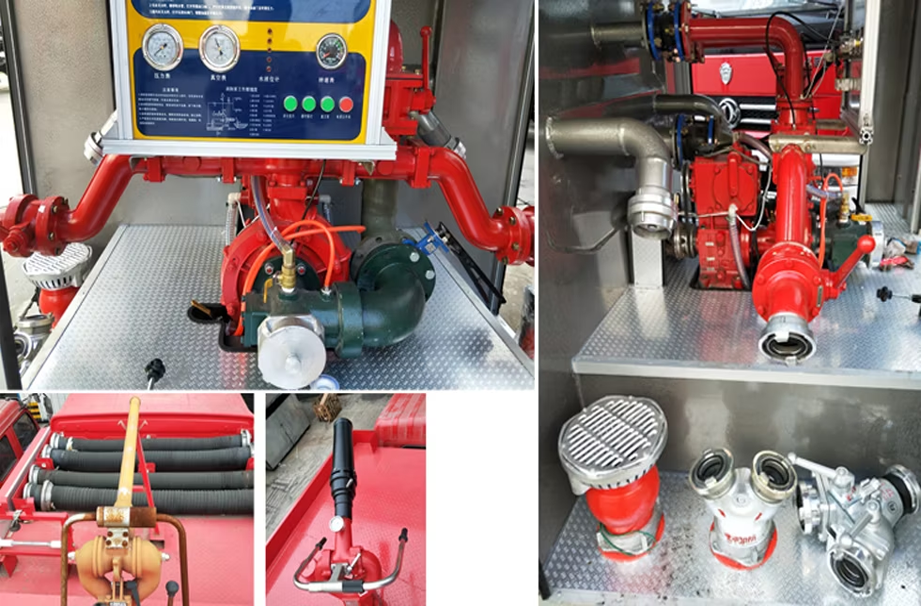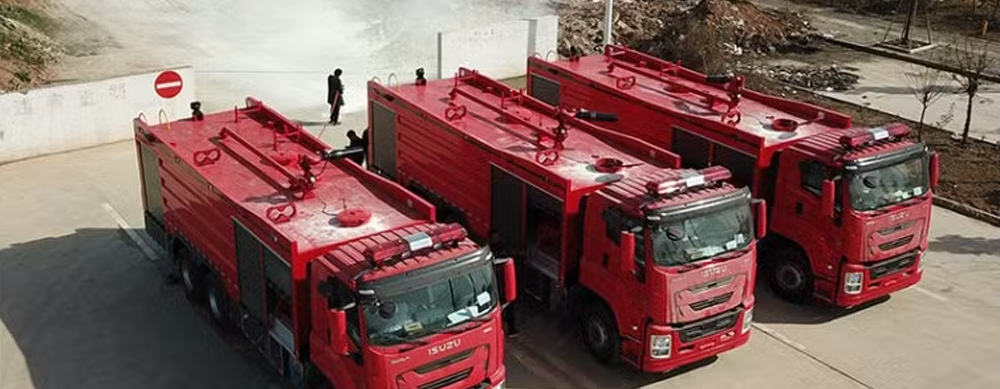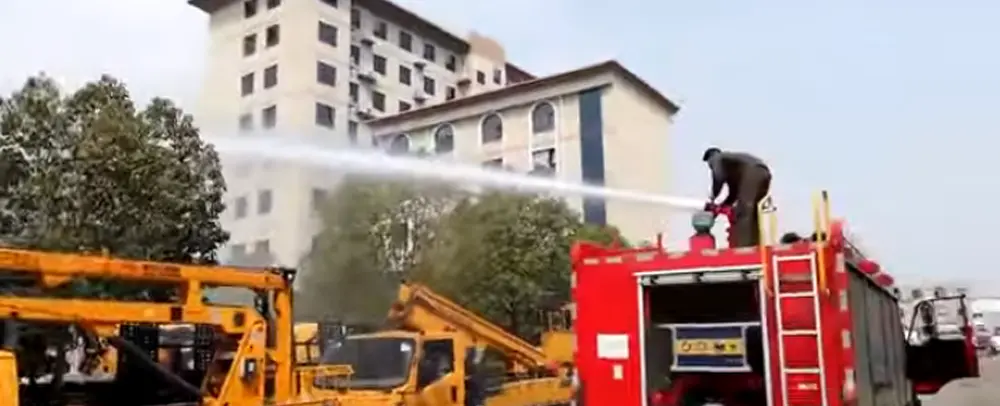Fire rescue trucks are the vanguards of emergency response, engineered to combat fires and conduct life-saving rescues with remarkable efficiency. Built on a rugged, heavy-duty chassis made of high-strength steel, they can bear the weight of crucial equipment and brave any terrain during a rapid dispatch.
Equipped with a sizeable water tank and a powerful pump, they're ready to douse flames, shooting water jets with great force and reach. Additionally, an array of specialized rescue tools, such as hydraulic cutters, spreaders, and ventilation fans, are on board to extract trapped victims from wreckage.
The cab is designed for the comfort and focus of firefighters. It features ergonomic seats and intuitive controls, ensuring a swift journey to the scene. Bright flashing lights, sirens, and reflective markings enhance visibility, signaling their urgent mission and clearing a path through traffic, making them indispensable assets for safeguarding lives and property.
| 16,000L fire truck water tanker powder foam 4000 gallon fire rescue truck | ||
| General | Overall Dimension | 11995x2550x3800mm |
| GVW Weight | 42000kg | |
| Approach/departure angle | 17/13 (°) | |
| Cab | Cab Seat | 5,6 |
| Air Conditioner | optional | |
| Chassis | Drive Type | 8*4 |
| Transmission | Manual | |
| Wheelbase | 1850+4575+1370 | |
| Tyre Specification | 315/80R22.5 | |
| Tyre No. | 12+1 | |
| Max Speed | 98km/h | |
| Paint | Red or as request | |
| Engine | Fuel Type | diesel |
| Engie Model | 6WG1-TCG51 | |
| Power | 339kw/460hp | |
| Displacement | 15681cc | |
| Emmission Standard | Euro 5 | |
| Superstructure | Water Tank | 12000L with carbon steel |
| Foam Tank | 3400L with stainless steel | |
| Powder Tank | 2000L with stainless steel | |
| Others | Water Pump | CB10/100,100L/S |
| Fire Monitor(water & foam) | PL80W,80L/S | |
| Fire Monitor(Powder) | PF30 | |

1. The chassis of a fire rescue truck is its sturdy foundation, typically fabricated from thick, high-strength steel plates. It must endure the heavy load of not just the water tank and firefighting apparatus but also an assortment of rescue tools and the crew.
2. A significant water tank is a core component, with capacities ranging from a few thousand to tens of thousands of liters, depending on the truck's scale and intended use. It's made of corrosion-resistant materials to maintain water quality.
3. Fire rescue trucks feature dedicated compartments to store a diverse range of rescue tools. These include hydraulic cutters and spreaders for extricating victims trapped in vehicle wrecks, forcible entry tools like axes and pry bars for breaking through barriers, and ventilation fans to clear smoke and fumes from confined spaces.
4. Multiple hose reels are installed around the truck, holding hoses of various lengths and diameters. Longer hoses allow firefighters to reach fires that are far from the vehicle, while different diameters suit different water flow requirements.
5. Many fire rescue trucks are equipped with extendable ladders or aerial platforms. Telescopic ladders can extend to remarkable heights, sometimes over 100 feet, facilitating access to upper floors of burning buildings.
6. The cab is designed with the comfort and functionality of the crew in mind. It has ergonomic seats to reduce fatigue during long emergency rides. The controls for driving the truck, like the steering wheel, accelerator, brakes, and transmission, are laid out intuitively.

1. Water Tank Capacity: The size of the water tank is a crucial factor. Consider the area you serve and the typical fire scenarios. If you're in an urban area with good access to hydrants, a smaller tank (around 3,000-5,000 liters) might be sufficient.
2. Pump Performance: The pump's power and flow rate are vital. A high-pressure pump with a good flow rate (e.g., 1,000-2,000 gallons per minute) is necessary to project water to the required heights and distances.
3. Tool Variety: Look for a truck that comes equipped with a comprehensive set of rescue tools. Hydraulic cutters and spreaders are essential for vehicle extrication.
4. Storage and Accessibility: The rescue equipment compartment should be well-designed for easy access. The tools should be organized in a way that allows firefighters to quickly retrieve what they need.
5. Engine Power: The engine should have sufficient horsepower to carry the heavy load of the truck (including the water tank, rescue equipment, and crew) and still be able to respond quickly to emergencies.
6. Transmission and Suspension: A smooth-operating transmission is essential for quick gear-changing and efficient power delivery.
7. Operator's Comfort: The cab should have an ergonomic seat to reduce operator fatigue during long-haul responses.
8. Lights and Sirens: The fire rescue truck should have bright, visible lights (usually red and blue) and a powerful, adjustable-tone siren.

Fire rescue trucks are equipped with a high-capacity water tank, often holding several thousand to tens of thousands of liters of water or fire retardant agents.
These trucks carry an array of specialized rescue tools. Hydraulic cutters and spreaders are staples, allowing firefighters to extricate victims trapped in mangled vehicles with ease.
Multiple hoses of different lengths and diameters are stowed on the fire rescue truck. Longer hoses, sometimes stretching up to 100 meters or more, offer the reach necessary to access fires that are far from the vehicle.
Many fire rescue trucks feature extendable ladders or aerial platforms. Telescopic ladders can reach heights exceeding 100 feet, granting firefighters access to upper floors of burning structures.
The chassis is a heavy-duty, high-strength steel structure built to bear the weight of the water tank, firefighting equipment, and the crew.
Fire rescue trucks are decked out with a host of safety and visibility features. Bright, flashing lights, usually in red and blue, are mounted on the roof, front, and sides to command immediate attention on the road.
The cab is designed with the comfort of the driver and crew in mind. It houses ergonomic seats to reduce fatigue during long emergency responses. The controls for driving the truck are laid out intuitively.

